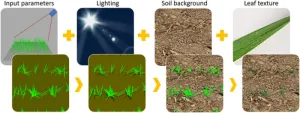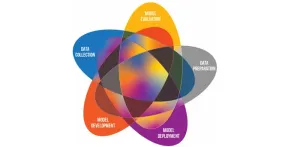(Press-News.org) A versatile new foam material developed by researchers at the University of Georgia could significantly reduce health care-related infections caused by implanted medical devices—or drastically improve cleanup efforts following environmental disasters like oil spills.
Like a spongy Swiss Army knife, the porous three-dimensional foam is water repellent—meaning it resists blood, microbes and proteins, while also exhibiting antimicrobial and oil-water separation properties. Its versatility, functionality and relatively inexpensive production costs could make it a valuable resource for future clinicians and environmental remediation professionals alike.
“Making a multifunctional and versatile surface is an extremely challenging task,” said Hitesh Handa, an associate professor in UGA’s School of Chemical, Materials and Biomedical Engineering. “You can find a surface that is only antimicrobial, or you can find one that can only prevent blood clotting. To be able to fabricate materials that are anticlotting, antimicrobial and antifouling is a significant improvement on current standards.”
The material is a coarse foam with a pair of added fillers: hydrophobic (or, water repellant) electrically conductive graphene nanoplatelets and hydrophobic bactericidal copper microparticles. In addition to repelling water, their inclusion created a coarse surface that facilitated high oil adsorption capacity and the copper, a known toxin to bacterial cells, added antimicrobial properties to the surface itself.
Studies of its effectiveness yielded positive results.
Using E. coli as a test bacterium, researchers found that the material resulted in a 99.9% bacterial reduction over a simple polymer. While that doesn’t mean that all bacteria had been removed from the solution, it is a significant improvement that Handa thinks could improve health outcomes for many of the more than 500,000 patients who endure health care-related infections from medical implants each year.
“Current medical devices are prone to contamination,” Handa said. “When you put any medical device into the body, proteins are the first thing to stick to a surface, and they act like a glue that allows blood or bacteria to adhere. So, if we can stop the protein adsorption, half the battle is won.”
Likewise, a series of tests demonstrated the material’s high capacity for separating water and other oil-based pollutants. By placing a 3D sponge made from this surface into a variety of water mixtures—chloroform, hydrochloric acid and other organic particles—researchers were able to show its ability to absorb and remove the organic pollutants from the water, while also killing bacteria in the water itself.
At scale, the material could prove impactful in environmental cleanup from oil spills or other similar scenarios.
The idea follows a phenomenon called the lotus effect, which refers to self-cleaning properties that are a result of ultrahydrophobicity exhibited by the lotus flower. This has long been a model for the fabrication of superhydrophobic surfaces that have proven effective at cleaning, antifogging and antifouling. Past design strategies, however, have fallen short due to a lack of functionality and scalability.
“The versatility is the key here,” said Mark Garren, a co-author on the paper and doctoral student in Handa’s lab. “The multifunctional properties are what inspired this, then developing that and showcasing all of its abilities.”
Going forward, the primary goal for researchers is to apply the surface to medical devices and demonstrate its effectiveness before moving on to non-human animal trials and, eventually, testing in humans. Facing less rigorous safety standards, the surface may be more readily deployable in the environmental cleanup use cases.
This research, titled “Superhydrophobic and Conductive Foams with Antifouling and Oil-Water Separation Properties” was published in the American Chemical Society’s Applied Materials & Interfaces January issue.
END
Researchers create antimicrobial ‘superfoam’
The three-dimensional foam conducts electricity, cleans polluted water
2023-04-26
ELSE PRESS RELEASES FROM THIS DATE:
Integrative neuro-oncology for brain tumor patients
2023-04-26
The University of Cincinnati's Soma Sengupta, MD, PhD, published an article in the Journal of Neuro-Oncology April 25 discussing her journey and approach to practicing integrative neuro-oncology.
Sengupta, associate professor in neurology, director of neuro-oncology clinical trials, associate director of the Brain Tumor Center and a UC Health neuro-oncologist, funded by the Harold C. Schott Endowed Chair in Molecular Therapeutics (Neurosurgery) and the Pam and Tom Mischell Funds, said she personally ...
A high-throughput AI method for leaf counting
2023-04-26
In cereal crops, the number of new leaves each plant produces is used to study the periodic events that constitute the biological life cycle of the crop. The conventional method of determining leaf numbers involves manual counting, which is slow, labor-intensive, and usually associated with large uncertainties because of the small sample sizes involved. It is thus difficult to get accurate estimates of some traits by manually counting leaves.
Conventional methods have, however, been improved upon with technology. Deep learning has enabled the use of object detection and segmentation algorithms to estimate the number of plants (and ...
Humidity may increase heat risk in urban climates
2023-04-26
As temperatures across the globe reach record-level highs, urban areas are facing increased heat stress. Cities are generally warmer and dryer than adjacent rural land. But in the Global South, there is an additional complicating factor — urban humid heat.
A new study, led by Yale School of the Environment scientists and published in Nature, investigated the combined effect of temperature and humidity on urban heat stress using observational data and an urban climate model calculation. Researchers found that the heat stress burden is dependent on local climate and a humidifying effect can erase the cooling benefits that would come from trees and vegetation.
“A widely ...
Roadmap to fair AI: revealing biases in AI models for medical imaging
2023-04-26
Artificial intelligence and machine learning (AI/ML) technologies are constantly finding new applications across several disciplines. Medicine is no exception, with AI/ML being used for the diagnosis, prognosis, risk assessment, and treatment response assessment of various diseases. In particular, AI/ML models are finding increasing applications in the analysis of medical images. This includes X-ray, computed tomography, and magnetic resonance images. A key requirement for the successful implementation of AI/ML models in ...
Thinking on different wavelengths to improve photopolymer-based 3D printing
2023-04-26
As additive manufacturing becomes more commonplace, researchers are exploring new methods to ensure that products are as strong and more sustainable than their traditionally manufactured analogues. At the University of Pittsburgh, engineers have set their sights on using multiple lights and neural networks to improve the finishing process of this complex process.
Xiayun Zhao, assistant professor of mechanical engineering and materials science at Pitt’s Swanson School of Engineering, received a Faculty Early Career Development (CAREER) award from the National Science Foundation (NSF) for her research in photopolymer additive manufacturing (PAM). ...
What happens when teens privately ask for help on Instagram?
2023-04-26
Revelations and research over the last few years have shed light on how Instagram may negatively affect its youngest users. The most popular social media platform among 13- to 21-year-olds in America, Instagram was designed to connect people with shared interests. However, recent research has pointed to the use of social media as possibly contributing to a rise in mental health and eating disorders among teenage girls. Researchers at Drexel University and Vanderbilt University are trying to figure out exactly what young users are experiencing on Instagram, in hopes of curtailing the negative trend and getting them the support they need.
In ...
Oregon State University researcher will receive top global forestry award from Swedish king
2023-04-26
CORVALLIS, Ore. – Darius Adams, professor emeritus in the Oregon State University College of Forestry, is one of three researchers sharing this year’s international Marcus Wallenberg Prize for developing a pair of groundbreaking forest economic models.
The annual prize, one of the highest honors in the field of forestry, was announced last week in Sweden and is named for the late Marcus Wallenberg Jr., a banker, industrialist and member of Sweden’s long-influential Wallenberg family.
Adams is the second Wallenberg awardee from the College of Forestry in the last three years. In 2020 another OSU professor emeritus, Richard ...
Instead of refuting misinformation head-on, try “bypassing” it
2023-04-26
It’s tempting to argue with someone who is misinformed by showing them studies and articles that prove they’re wrong. But new research shows that there’s another, less confrontational, way to get someone to change their mind.
A new study in Scientific Reports, led by Dolores Albarracín, a social psychologist who specializes in attitudes and persuasion, and the Alexandra Heyman Nash Penn Integrates Knowledge University Professor at the University of Pennsylvania, has found that “bypassing” misinformation is just as effective as debunking it head-on.
This ...
AGS honors Dr. Alan Lazaroff for his commitment to geriatrics with the David H. Solomon Public Service Award
2023-04-26
New York (April 26, 2023) — Today, the American Geriatrics Society (AGS) announced that it will be honoring Alan Lazaroff, MD, AGSF with its David H. Solomon Memorial Public Service Award, for his passionate advocacy to better align Medicare payment to meet the unique healthcare needs of older adults and to improve care coordination for patients with chronic conditions.
“Dr. Lazaroff has been involved with the work of the American Geriatrics Society for over 25 years,” said AGS President G. Michael Harper, MD, AGSF. “When the AMA/Specialty Society Relative Value ...
BMI and the adolescent brain: A concerning association
2023-04-26
Obesity is a growing epidemic in children and adults. A large national study published in the International Journal of Obesity now finds that preteens carrying excess weight have notable differences in cognitive performance, brain structures, and brain circuitry when compared to preteens with normal body-mass index (BMI).
Funded by the National Science Foundation’s Harnessing the Data Revolution initiative, the study involved nearly 5,000 9- to 10-year-olds at 21 sites across the United States. While it only examines the relationship between BMI and the brain and cannot establish causation, there is a significant association between ...
LAST 30 PRESS RELEASES:
Injectable breast ‘implant’ offers alternative to traditional surgeries
Neuroscientists devise formulas to measure multilingualism
New prostate cancer trial seeks to reduce toxicity without sacrificing efficacy
Geometry shapes life
A CRISPR screen reveals many previously unrecognized genes required for brain development and a new neurodevelopmental disorder
Hot flush treatment has anti-breast cancer activity, study finds
Securing AI systems against growing cybersecurity threats
Longest observation of an active solar region
Why nail-biting, procrastination and other self-sabotaging behaviors are rooted in survival instincts
Regional variations in mechanical properties of porcine leptomeninges
Artificial empathy in therapy and healthcare: advancements in interpersonal interaction technologies
Why some brains switch gears more efficiently than others
UVA’s Jundong Li wins ICDM’S 2025 Tao Li Award for data mining, machine learning
UVA’s low-power, high-performance computer power player Mircea Stan earns National Academy of Inventors fellowship
Not playing by the rules: USU researcher explores filamentous algae dynamics in rivers
Do our body clocks influence our risk of dementia?
Anthropologists offer new evidence of bipedalism in long-debated fossil discovery
Safer receipt paper from wood
Dosage-sensitive genes suggest no whole-genome duplications in ancestral angiosperm
First ancient human herpesvirus genomes document their deep history with humans
Why Some Bacteria Survive Antibiotics and How to Stop Them - New study reveals that bacteria can survive antibiotic treatment through two fundamentally different “shutdown modes”
UCLA study links scar healing to dangerous placenta condition
CHANGE-seq-BE finds off-target changes in the genome from base editors
The Journal of Nuclear Medicine Ahead-of-Print Tip Sheet: January 2, 2026
Delayed or absent first dose of measles, mumps, and rubella vaccination
Trends in US preterm birth rates by household income and race and ethnicity
Study identifies potential biomarker linked to progression and brain inflammation in multiple sclerosis
Many mothers in Norway do not show up for postnatal check-ups
Researchers want to find out why quick clay is so unstable
Superradiant spins show teamwork at the quantum scale
[Press-News.org] Researchers create antimicrobial ‘superfoam’The three-dimensional foam conducts electricity, cleans polluted water




